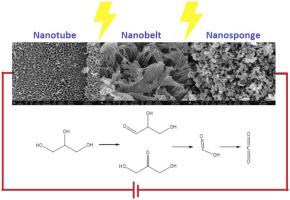Journal of Environmental Chemical Engineering ( IF 7.7 ) Pub Date : 2022-01-17 , DOI: 10.1016/j.jece.2022.107210 Sıdıka Çetinkaya 1 , Gofur Khamidov 1 , Levent Özcan 2 , Leonardo Palmisano 3 , Sedat Yurdakal 1

|
Photoelectrocatalytic (PEC) oxidation of glycerol to commercially valuable compounds was carried out using nanotube, nanobelt and nanosponge TiO2 on Ti plates prepared by anodic oxidation method. The plates were characterized by XRD, SEM and electrochemical methods (photocurrent profiles and EIS). Glycerol oxidation experiments were carried out under environmentally friendly conditions using air/water as oxidant and water as solvent under UVA irradiation. Glyceraldehyde, 1,3-dihydroxyacetone, formic acid and CO2 were determined as glycerol products. The effects of photoanode morphology, TiO2 crystallinity, applied potential, pH, solution mixing speed, electrolyte type (and concentration) and gas atmosphere on the glycerol oxidation activity and product selectivity were investigated in detail. In addition, the hole trap effect of methanol was also investigated. Optimum conditions were achieved with anatase phase nanotube structured TiO2 photoanodes in the presence of 20 mM Na2SO4, by applying 1.5 V bias, and 400 rpm solution mixing speed at pH 7 in air atmosphere. Electrocatalytic and photocatalytic experiments were performed in order to compare them, and in the first case no activity was observed, while in the second case it was low. The disappointing results obtained by using the single methods demonstrated the presence of a synergistic effect in the PEC experiments. Moreover, the electrode prepared by simple thermal oxidation of the Ti plate showed no activity in the PEC tests, unlike the structures in which TiO2 nanotubes, nanosponges and nanobelts were present which showed significant activity due to the high specific surface area and their other morphological and structural characteristics.
中文翻译:

钛板上纳米管、纳米带和纳米海绵结构二氧化钛对甘油的选择性光电催化氧化
使用纳米管、纳米带和纳米海绵 TiO 2在通过阳极氧化法制备的钛板上进行甘油的光电催化 (PEC) 氧化为具有商业价值的化合物。通过 XRD、SEM 和电化学方法(光电流曲线和 EIS)对板进行表征。甘油氧化实验在环境友好的条件下进行,使用空气/水作为氧化剂,水作为溶剂,在 UVA 照射下进行。甘油醛、1,3-二羟基丙酮、甲酸和CO 2被确定为甘油产物。光阳极形态的影响,TiO 2详细研究了结晶度、外加电位、pH、溶液混合速度、电解质类型(和浓度)和气体气氛对甘油氧化活性和产物选择性的影响。此外,还研究了甲醇的空穴陷阱效应。在存在 20 mM Na 2 SO 4的情况下,使用锐钛矿相纳米管结构的 TiO 2光阳极实现了最佳条件,通过在空气气氛中在 pH 7 下施加 1.5 V 偏压和 400 rpm 溶液混合速度。为了比较它们,进行了电催化和光催化实验,在第一种情况下没有观察到活性,而在第二种情况下它很低。通过使用单一方法获得的令人失望的结果表明在 PEC 实验中存在协同效应。此外,通过钛板的简单热氧化制备的电极在 PEC 测试中没有表现出活性,这与存在 TiO 2纳米管、纳米海绵和纳米带的结构不同,由于高比表面积和其他形态学表现出显着的活性。和结构特点。



























 京公网安备 11010802027423号
京公网安备 11010802027423号